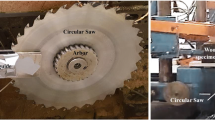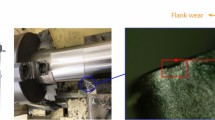Abstract
One of the most important parameters in machining process is tool wear. Thus, monitoring the wear of cutting tools is essential to ensure product quality, increase productivity, reduce environmental impact and avoid catastrophic damages. As wear is related to the vibrations of the process, the vibration signal is commonly used to monitor the process non-intrusively. Traditional wear monitoring techniques present a number of problems such as: the difficulty of identifying vibration features sensitive to wear evolution, the specialist requirement for supervising the model training and an endless series of tests to work with balanced data. To overcome these difficulties, this paper aims to propose a new approach in the application of unsupervised artificial intelligence technique with imbalanced data to identify the cutting tool wear condition during the turning process. The methodology will allow industrial applications since no supervision is required in the model training when machining condition is changed. From vibration signals collected during each tool pass, a self-organizing map model was used to identify the ideal moment of tool change. The classifier used was compared to benchmark supervised methods (weighted k-nearest neighbor and support vector machine). Imbalanced data sets were used to simulate the industrial reality. Tool tests were performed under different wear conditions and changing the cutting parameters. The results showed that it is possible to predict the cutting tool wear condition with a self-organizing map neural for imbalanced data, using only the vibration signal with up to 92% accuracy.










Similar content being viewed by others
References
Arabmakki, E., & Kantardzic, M. (2017). SOM-based partial labeling of imbalanced data stream. Neurocomputing, 262, 120–133.
Burnap, P., French, R., Turner, F., & Jones, K. (2018). Malware classification using self organising feature maps and machine activity data. Computers & Security, 73, 399–410.
Cai, Q., He, H., & Man, H. (2014). Imbalanced evolving self-organizing learning. Neurocomputing, 133, 258–270.
Demircan, S., & Kahramanli, H. (2018). Application of fuzzy C-means clustering algorithm to spectral features for emotion classification from speech. Neural Computing and Applications, 29, 59–66.
Dudani, S. A. (1976). The distance-weighted k-nearest neighbor rule. IEEE Transactions on System, Man, and Cybernetics, 6, 325–327.
Fix, E., & Hodges, J. L. (1951). Discriminatory analysis, nonparametric discrimination: Consistency properties. U.S. Air Force School of Aviation Medicine, Project 21-49-004. Technique Report no. 4, Randolf Field Texas.
Gajate, A., Haber, R., Toro, R., Vega, P., & Bustillo, A. (2012). Tool wear monitoring using neuro-fuzzy techniques: A comparative study in a turning process. Journal of Intelligent Manufacturing, 23, 869–882.
Grubbs, F. E. (1969). Procedures for detecting outlying observations in samples. Technometrics, 11(1), 1–21.
Hassana, M., Damirb, A., Attiaa, H., & Thomsona, V. (2018). Benchmarking of pattern recognition techniques for online tool wear detection. Procedia CIRP, 72, 1451–1456.
Huang, Z., Zhu, J., Lei, J., Li, X., & Tian, F. (2019). Tool wear predicting based on multi-domain feature fusion by deep convolutional neural network in milling operations. Journal of Intelligent Manufacturing, 31, 953–966. https://doi.org/10.1007/s10845-019-01488-7.
Jain, D. K., Dubey, S. B., Choubey, R. K., Sinhal, A., Arjaria, S. K., Jain, A., et al. (2018). An approach for hyperspectral image classification by optimizing SVM using self organizing map. Journal of Computational Science, 25, 252–259.
Jurkovic, Z., Cukor, G., Brezocnik, M., & Brajkovic, T. (2018). A comparison of machine learning methods for cutting parameters prediction in high speed turning process. Journal of Intelligent Manufacturing, 29, 1683–1693.
Kannatey-Asibu, E., Yum, J., & Kim, T. H. (2017). Monitoring tool wear using classifier fusion. Mechanical Systems and Signal Processing, 85, 651–661.
Kohonen, T. (1995). Self-organizing maps (2nd ed.). Berlin: Springer.
Kong, D., Chen, Y., Li, N., Duan, C., Lu, L., & Chen, D. (2019). Relevance vector machine for tool wear prediction. Mechanical Systems and Signal Processing, 127, 573–594.
Lee, W. J., Wu, H., Yun, H., Kim, H., Jun, M. B. G., & Sutherland, J. W. (2019). Predictive maintenance of machine tool systems using artificial intelligence techniques applied to machine condition data. Procedia CIRP, 80, 506–511.
Lia, Z., Fang, H., Huang, M., Wei, Y., & Zhang, L. (2018). Data-driven bearing fault identification using improved hidden Markov model and self-organizing map. Computers and Industrial Engineering, 116, 37–46.
Liu, C., Li, Y., Hua, J., Lu, N., & Mou, W. (2018a). Real-time cutting tool state recognition approach based on machining features in NC machining process of complex structural parts. The International Journal of Advanced Manufacturing Technology, 97, 229–241.
Liu, M., Takagi, J., & Tsukuda, A. (2004). Effect of tool nose radius and tool wear on residual stress distribution in hard turning of bearing steel. Journal of Materials Processing Technology, 150(3), 234–241.
Liu, Y., Wang, X., & Yan, K. (2018b). Hand gesture recognition based on concentric circular scan lines and weighted K-nearest neighbor algorithm. Multimedia Tools and Applications, 77, 209–223.
Lokesh, S., Kumar, P. M., Devi, M. R., Parthasarathy, P., & Gokulnath, C. (2019). An automatic tamil speech recognition system by using bidirectional recurrent neural network with self-organizing map. Neural Computing and Applications, 31, 1521–1531.
Lu, S., Lu, Z., Wang, S., Chen, X. & Zhang, Y. (2017). Flower classification based on single petal image and machine learning methods. In 13th international conference on natural computation, fuzzy systems and knowledge discovery (ICNC-FSKD), Guilin (pp. 826–883).
Lu, M., & Wan, B. (2013). Study of high-frequency sound signals for tool wear monitoring in micromilling. International Journal of Advanced Manufacturing Technology, 66, 1785–1792.
Meng, X., Nie, L., & Song, J. (2019). Big data-based prediction of terrorist attacks. Computers and Electrical Engineering, 77, 120–127.
Mikaeil, R., Haghshenas, S. S., & Hoseinie, S. H. (2018). Rock penetrability classification using artificial bee colony (ABC) algorithm and self-organizing map. Geotechnical and Geological Engineering, 36, 1309–1318.
Mikołajczyk, T., Nowicki, K., Bustillo, A., & Yu Pimenov, D. (2018). Predicting tool life in turning operations using neural networks and image processing. Mechanical Systems and Signal Processing, 104, 503–513.
Mutheneni, S. R., Mopuri, R., Naish, S., Gunti, D., & Upadhyayula, S. M. (2018). Spatial distribution and cluster analysis of dengue using self organizing maps in Andhra Pradesh, India, 2011–2013. Parasite Epidemiology and Control, 3, 52–61.
Nguwi, Y., & Cho, S. (2010). An unsupervised self-organizing learning with support vector ranking for imbalanced datasets. Expert Systems with Applications, 37, 8303–8312.
Nouri, M., Fussell, B. K., Ziniti, B. L., & Linder, E. (2015). Real-time tool wear monitoring in milling using a cutting condition independent method. International Journal of Machine Tools and Manufacture, 89, 1–13.
Pandiyana, V., Caesarendrab, W., Tjahjowidodoa, T., & Tana, H. H. (2018). In-process tool condition monitoring in compliant abrasive belt grinding process using support vector machine and genetic algorithm. Journal of Manufacturing Processes, 31, 199–213.
Prasad, B. S., & Babu, M. P. (2017). Correlation between vibration amplitude and tool wear in turning: Numerical and experimental analysis. Engineering Science and Technology, an International Journal, 20, 197–211.
Rizal, M., Ghani, J. A., Nuawi, M. Z., & Haron, C. H. C. (2017). Cutting tool wear classification and detection using multi-sensor signals and Mahalanobis-Taguchi system. Wear, 376–377, 1759–1765.
Rmili, W., Ouahabi, A., Serra, R., & Leroy, R. (2016). An automatic system based on vibratory analysis for cutting tool wear monitoring. Measurement, 77, 117–123.
Santhanam, T., & Padmavathi, M. S. (2015). Application of k-means and genetic algorithms for dimension reduction by integrating SVM for diabetes diagnosis. Procedia Computer Science, 47, 76–83.
Sevilla, P., Robles, J., Jauregui, J., & Jimenez, D. (2015a). FPGA-based reconfigurable system for tool condition monitoring in high-speed machining process. Measurement, 64, 81–88.
Sevilla, P., Robles, J., Muñiz, J., & Lee, F. (2015b). Tool failure detection method for high-speed milling using vibration signal and reconfigurable bandpass digital filtering. International Journal of Advanced Manufacturing Technology, 81, 1187–1194.
Sharif, M., Khan, M. A., Zahid, F., Shah, J. H., & Akram, T. (2019). Human action recognition: A framework of statistical weighted segmentation and rank correlation-based selection. Pattern Analysis and Applications, 23, 281–294.
Siddhpura, A., & Paurobally, R. (2013). A review of flank wear prediction methods for tool condition monitoring in a turning process. International Journal of Advanced Manufacturing Technology, 65, 371–393.
Silva, R. H. L., Silva, M. B., & Hassui, A. (2016). A probabilistic neural network applied in monitoring tool wear in the end milling operation via acoustic emission and cutting power signals. Machining Science and Technology, 20(3), 386–405.
Suna, H., Lv, G., Mo, J., Lv, X., Du, G., & Liu, Y. (2019). Application of KPCA combined with SVM in Raman spectral T discrimination. Optik: International Journal for Light and Electron Optics, 184, 214–219.
Trent, E. M., & Wright, P. K. (2000). Metal cutting (4th ed.). Oxford: Butterworth-Heinemann.
Unler, A., Murat, A., & Chinnam, R. B. (2011). mr2PSO: A maximum relevance minimum redundancy feature selection method based on swarm intelligence for support vector machine classification. Information Sciences, 181, 4625–4641.
Vapnik, V. N., Golowich, S. E., & Smola, A. (1996). Support vector method for function approximation, regression estimation, and signal processing. Advances in Neural Information Processing Systems, 9, 281–287.
Wang, C., Caja, J., & Gómez, E. (2018). Comparison of methods for outlier identification in surface characterization. Measurement, 117, 312–325.
Wang, G., Zhang, Y., Liu, C., Qinglu, X., & Yonggang, X. (2019). A new tool wear monitoring method based on multi-scale PCA. Journal of Intelligent Manufacturing, 30, 113–122.
Wu, X., Yang, J., & Wang, S. (2018). Tea category identification based on optimal wavelet entropy and weighted k-nearest neighbors algorithm. Multimedia Tools and Applications, 77, 3745–3759.
Xia, C., Zhang, M., & Cao, J. (2018). A hybrid application of soft computing methods with wavelet SVM and neural network to electric power load forecasting. Journal of Electrical Systems and Information Technology, 5, 681–696.
Xie, Z., Li, J., & Lu, Y. (2019). Feature selection and a method to improve the performance of tool condition monitoring. The International Journal of Advanced Manufacturing Technology, 100, 3197–3206.
Yen, C. L., Lu, M. C., & Chen, J. L. (2013). Applying the self-organization feature map (SOM) algorithm to AE-based tool wear monitoring in micro-cutting. Mechanical Systems and Signal Processing, 34, 353–366.
Zendehboudi, A., Baseer, M. A., & Saidur, R. (2018). Application of support vector machine models for forecasting solar and wind energy resources: A review. Journal of Cleaner Production, 199, 272–285.
Zhou, Y., & Xue, W. (2018). Review of tool condition monitoring methods in milling processes. International Journal of Advanced Manufacturing Technology, 96, 2509–2523.
Acknowledgements
The authors gratefully acknowledge the Brazilian research funding agencies CNPq (National Council for Scientific and Technological Development), CAPES (Federal Agency for the Support and Improvement of Higher Education), and FAPEMIG (Minas Gerais State Research Foundation) for their financial support of this work.
Author information
Authors and Affiliations
Corresponding author
Additional information
Publisher's Note
Springer Nature remains neutral with regard to jurisdictional claims in published maps and institutional affiliations.
Rights and permissions
About this article
Cite this article
Brito, L.C., da Silva, M.B. & Duarte, M.A.V. Identification of cutting tool wear condition in turning using self-organizing map trained with imbalanced data. J Intell Manuf 32, 127–140 (2021). https://doi.org/10.1007/s10845-020-01564-3
Received:
Accepted:
Published:
Issue Date:
DOI: https://doi.org/10.1007/s10845-020-01564-3




